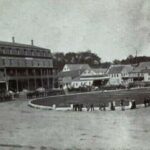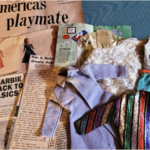Yester-Heros: Stories from the History of Nashua’s Police and Fire-Rescue Departments.

May 4, 1930: It was a typical early summer day, a Sunday morning in Nashua. The Nashua Telegraph of the previous day predicted fair and cooler weather for Sunday. A fire started on one of the lower wooden timbers of a railroad bridge over the Nashua River near Temple Street. It is unknown what started the fire. It might have been sparks from a passing train. It might have come from a group of young men who were known to congregate in the area to while away the time with games of chance and cigarette smoking.
Nashua firefighters were alerted. A chemical hose truck responded but could not reach the source of the flames underneath the bridge. The fire grew. At 2 p.m. Box 9 on the corner of Temple and South streets was rung and the race was on. Despite two hose streams already playing on the bridge, the flames continued to grow.

A stiff wind of almost gale proportions drove sparks and firebrands south starting other buildings on fire. Additional alarms were sounded at 2:17 p.m., 2:40 p.m., and 2:45 p.m. Every piece of firefighting equipment and every Nashua firefighter responded. Mutual aid was requested from Hudson, Merrimack, Lowell, Manchester, and Hollis.
The fire continued to advance despite all efforts. At 2:46 p.m. Box 49 at East Hollis and Marshal Street was struck, and less than 45 minutes later, Box 46 at Bowers and Allds streets was struck. At 3:40 p.m. and again at 4:31 p.m., calls went out for military assistance. Calls were answered from a 300-man contingency of National Guard soldiers from Manchester who patrolled those streets under siege to guard against looting.
The fire worked its way down South Street, it leaped Worchester Street, then onto Spruce Street. It then headed east to the Proctor Brothers, a vast lumberyard fronting E. Hollis Street between Marshal and Allds streets. With Proctor Brothers and its neighbor, the White Mountain Freezer Company, each storing vast amounts of lumber for their business needs, the fire had plenty of ready fuel. The two businesses would be left in ruins. And most unfortunately, they employed over 200 people. The firefighters fought on, knowing how great the odds against them had become.
In front of the fast-moving fire, residents were moving out their valuables and keepsakes. Neighbor helped neighbor move furniture onto lawns and open areas. Several area businesses with delivery trucks, including C.H. Avery furniture company, went up and down the streets offering to help residents move their furniture to a safe place.
Archival accounts note that although the burning embers were flying everywhere with the stiff wind torching everything in their path, oddly, some homes and buildings were miraculously spared. Some photographic and anecdotal evidence during the research of this project confirm that story. Several long-time Crown Hill residents noted that the home then occupied by their parents or grandparents was spared while everything around them was burned flat.


Telephone poles burned until they fell over and blocked streets. The fire moved along Allds Street and to Burke Street, and here sparks fell upon the first section of lumber owned by the American Box and Lumber Company. Here, acres of stacked boards quickly became fuel for the raging furnace. The fire even jumped across the Merrimack River to burn several buildings at the Kashulinas Farm.
Beyond the yard of the American Box and Lumber Company was a meadow leading to a pine grove extending to the Nashua Country Club. Fearing the fire would quickly work its way across this expanse, Country Club employees kept the roof of their facilities wet to ward off any hot embers. But the flames turned and went by to the east.
At the time of the fire, the Nashua Fire Department was equipped with four engines with 1000-gallon-per-minute pumps, five combination cars with booster pumps and tanks, one aerial ladder truck, three city service trucks, 43 full-time men, 17 call men with total manpower of 60. Ultimately, 19 other fire departments from NH and MA sent equipment and firefighters. Some towns could not spare the equipment but sent firefighters. Without being called, firefighters from Lawrence, Winchester, Lexington and Belmont Massachusetts, responded to the city. In a short time over 30 high-powered pumping engines and their crews were flanking the burning district.
The fire was brought under control around midnight but in no way extinguished. Firefighters would be overhauling structures for another seven hours for a total of a 19-hour call. Thirty-two firefighters were treated for injuries at Central Station and 24 were treated at the hospital. Many were overcome by smoke and taken to Memorial Hospital.
Miraculously, the conflagration did not have one fatality in the course of the blaze. However, Lowell Fire Capt. George McDermott, while battling the fire, fell down a flight of stairs requiring later surgery. He died June 23, 1930, from complications of the surgery.
During the 19 hours firefighters battled the blaze, a total of 5,250,000 gallons of water were pumped into the fire area. A total of 400 buildings were burned to the ground or damaged; 125 families lost their homes, 600 people were out of work. The total loss was estimated at over $2M This is about $32M in 2021 dollars. According to insurance underwriters of the day, less than half were insured.
Some people rebuilt their homes right on the existing foundation…which was all that was left. Evidence of the fire could be found well into the 1970s where abandoned cellar holes and small sections of foundations could still be seen. While some people rebuilt, others just… disappeared, leaving only cellar holes as evidence of their life there.
Excerpted from “Nashua’s Bravest: The History of Firefighting in Nashua NH”

About the Author: Yester-Heros” author Gary Ledoux grew up in Nashua’s Crown Hill area, attending Nashua schools and graduating from Nashua High in 1970. He attended NH Vo-Tech for a time, then moved to Amherst, then Manchester, and Weare. He served as a volunteer on the Amherst Fire Dept from 1974 to 1977. A career in the automotive business took him to Florida and then to southern California. After 48 years, he retired in 2017, moving back to Florida with his wife, Rachel, and two dogs. He has published seven books, including two about Nashua history, and has been a contributing editor or contributor to 10 different magazines. He would love your feedback at mayorclum@yahoo.com








